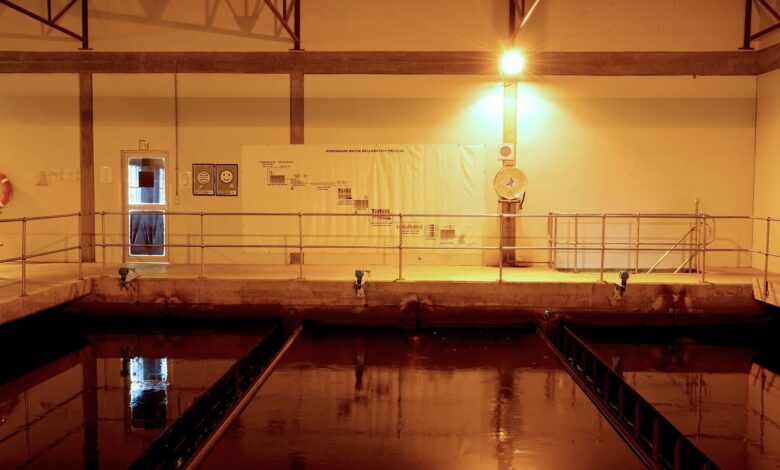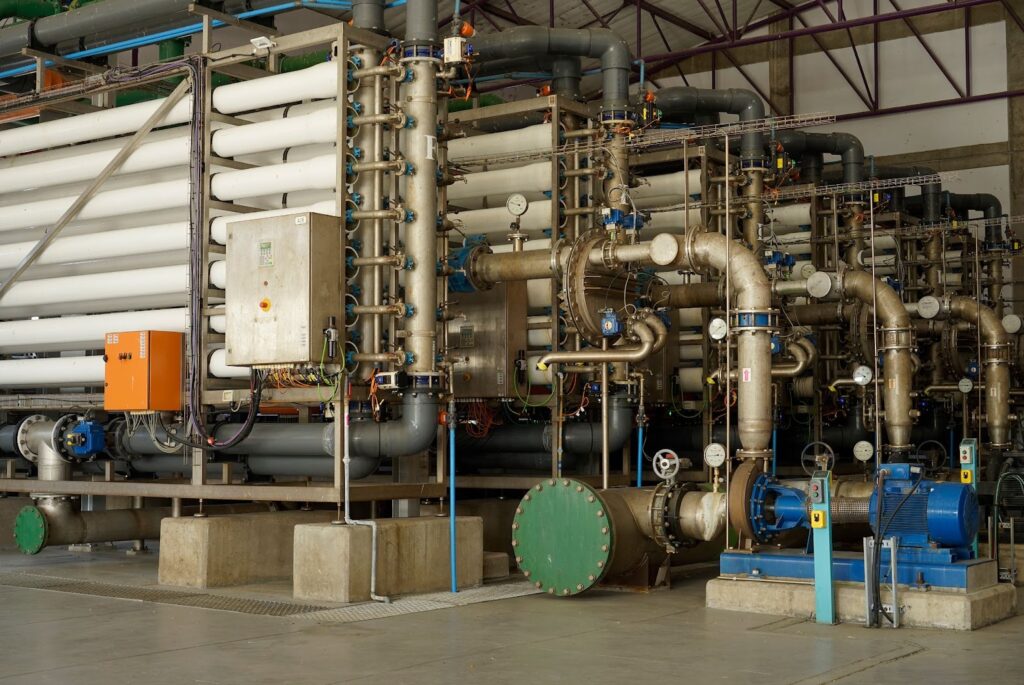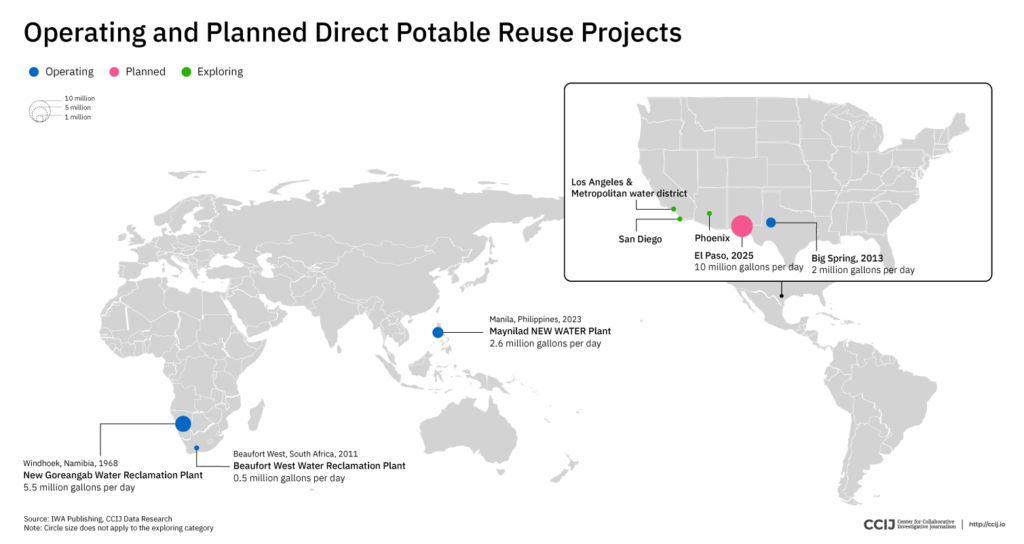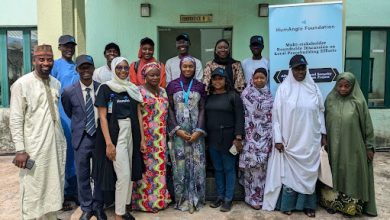What The World Can Learn From Africa’s ‘Cradle Of Water Reclamation’
Namibia’s water problem is not a recent phenomenon. Fifty-five years ago, on the outskirts of Windhoek, government officials recognized the capital city was on the verge of a major water crisis. In response, they helped pioneer water reclamation technology that has allowed Windhoek, a city of almost half a million residents, to thrive.

As one of the driest countries in sub-Saharan Africa, Namibia is no stranger to water scarcity issues. Since 2012, the southern African country – known for its sprawling arid landscapes and limited seasonal rainfall – has declared four national emergencies due to extreme drought events.
But this problem is not a recent phenomenon. Fifty-five years ago, on the outskirts of Windhoek, government officials recognized the capital city was on the verge of a major water crisis. In response, they helped pioneer water reclamation technology that has allowed Windhoek, a city of almost half a million residents, to thrive.
Now, as water shortages grip all parts of the planet, the United States – usually a captain of scientific industry and innovation – is turning to Namibia for guidance.
The Colorado River’s impending crisis
The Colorado River, which meets the drinking demands of 40 million people in the US and Mexico, is in trouble. Megadrought conditions – a period of exceptionally severe and long-lasting dryness – have gripped the Southwest region of the US since 2001, impeding the river’s ability to feed Lake Mead and Lake Powell, the two largest reservoirs in the country.
And while a large winter snowpack and Tropical Storm Hilary may have helped temporarily pad the Southwest’s water supply, residents must still wrestle with the fact there simply isn’t enough water to go around. This is bad news for the region, home to some of the fastest-growing cities in the country.
“It has become very clear that state allocations of Colorado water are going to be reduced,” says Edith Zagona, director of the Center for Advanced Decision Support for Water and Environmental Systems at the University of Colorado Boulder. “We are getting to the stage where we are kind of desperate.”
Southwestern cities must undeniably take less from the river, but they also have another option – reuse what they already have. Scottsdale, Arizona, and Orange County, California, are among cities and counties that have already utilized water reclamation technology for decades to offset what they import from the Colorado River, but several states – including Texas, California and Colorado – are finally starting to embrace another method, once labelled the “final frontier” in water reuse.
Direct potable reuse, or DPR, is a system that eliminates pollutants and contaminants from sewage water through a multi-barrier process before it is introduced as purified and safe water into the drinking supply. Upon first reading, that may sound revolting, but it’s nothing new. It’s the way they’ve done it in Windhoek for over half a century.
The ‘cradle of water reclamation’
In the 1960s, Windhoek faced catastrophe as the city struggled to support its small but quickly growing population. As increased demand put groundwater supplies under stress, severe water shortages gripped the capital. But disaster forced innovation.
At the time, Windhoek considered treating sewage effluent as a resource, and after eight years of pilot studies, the Goreangab Water Reclamation Plant (GWRP) became the first in the world to produce purified drinking water directly from sewage water.
“It was the best technology of the time,” says Troy Walker, a water reuse practice leader at Hazen and Sawyer, an environmental engineering firm now helping to deliver potable reuse projects in the US. “The water was safe, [and] it solved a big problem.”
To meet the water demands of an expanding capital city after Namibian independence in 1990, the New Goreangab Wastewater Reclamation Plant (NGWRP) in Windhoek replaced the original reclamation plant in 2002. The facility is a jungle of state-of-the-art technology, tucked between two of the capital’s largest and poorest informal settlements, Havana and Goreangab.
Thomas Honer is the general manager, and his office is a no-frills cabin on the side of a hill, just meters away from where the water purification process takes place. He told CCIJ that the Namibian government knows how many contaminants are in sewage water – from dishwashing chemicals to cosmetic preservatives. And, he explained, that once his team finds them, they analyze, treat and remove them from the water.
“The most important rule is, and was, and always will be safety first,” Honer emphasizes. The City of Windhoek boasts that its DPR plant, which uses water quality standards measured against World Health Organization (WHO) guidelines, has never been linked to a waterborne disease outbreak.
When the original plant was commissioned, no regulations for potable reuse existed, but Windhoek’s standards for water quality met the guidelines set out by the WHO at the time. Nowadays, the water quality is still measured against WHO’s evolved guidelines, as well as Namibia’s own guidelines and South Africa’s water standards.
To meet these parameters, the NGWRP continuously maintains a multi-barrier treatment sequence that safeguards against pathogens and other potentially harmful and unwanted contaminants. This approach ensures that at least two, and in many cases three or more, effective removal processes are in place for any crucial contamination that could be harmful to human health or even just aesthetically objectionable.
Honer explains that online instruments continuously monitor the water. These send a signal every two seconds to the control room, where staff ensure that only drinking water within the water quality regulations is sent to the consumers. If inconsistencies are recorded at any stage, the plant goes into recycle mode, and distribution is halted until the correct values are restored.
The quality of the final water is then monitored and approved by the city’s public service lab, Gammams Laboratory, affectionately referred to as “the referee” by Honer. During the 24-hour production process, water samples are also taken on a four-hourly basis and analyzed in the onsite laboratory.
“It’s perfect,” says Sade Gawanas, former mayor of Windhoek. “We want water to be available to our people, and the plant is run beautifully.”
A 2014 study, carried out by the University of New South Wales (UNSW) and funded by the Australian Water Recycling Centre of Excellence, found that the Namibian facility had “a comprehensive water safety plan” should water quality be compromised. That’s crucial, because the NGWRP produces up to 5.5 million gallons of drinking water every day – up to 35% of the city’s consumption. DPR has also relieved the pressure on Windhoek’s groundwater supplies that were so depleted in the 1960s.
Simply put, Namibians couldn’t survive without it.
Providing sufficient drinking water to its citizens remains a challenge as the city’s population grows and its informal settlements expand. Providing enough water for non-potable use, such as sanitation, also remains a struggle for many Namibians on the outskirts of the city, who often have to walk long distances to access water from the tap. Since drinking water takes priority, they cannot always carry water for cooking, washing and cleaning.
But Windhoek – and the government at large – remain committed to meeting the water needs of all Namibians, and the city has been working to address levels of water stress that many other places will soon experience. As the world tackles climate change, Namibia remains influential in a way that few might suspect of a small, developing nation.

“It’s a really important scheme,” says Stuart Khan, a professor of environmental engineering at UNSW who specializes in advanced water treatment processes. “It was successful in providing a sustainable resource for Windhoek, and successful in setting an important precedent for other countries to follow.”
Five and a half decades later, Windhoek’s insights into these challenges and solutions are more pertinent than ever.
Challenges to implementing DPR
There are already several indirect potable reuse – or IPR – facilities reclaiming water in the US and around the world. IPR uses an almost identical treatment process to DPR but for the addition of an environmental buffer, such as a lake, reservoir or groundwater aquifer, where the water sits after a first round of treatment and is diluted with a raw water supply. The water is then treated again before it is distributed to the public.

However, the buffer is not always essential to quality assurance, and DPR cuts it out. This has several advantages. First, it can reduce the long-term energy costs of pumping energy to and from a buffer. Second, it is a more geographically flexible process that allows cities without a buffer to reclaim water.
“You can use existing infrastructure and do not have to build injection wells, extraction wells or long [and expensive] pipelines to a reservoir or a groundwater basin,” says Jeffrey Mosher, the former principal technologist at Carollo Engineers, an environmental engineering firm that specializes in wastewater facilities.
DPR is also fast. Wastewater can be reintroduced as drinking water within 24 hours, according to Sanaan Villalobos, vice president of Carollo Engineers. IPR, by contrast, takes significantly longer, with water sitting in the environment buffer for months before it is treated again.
Despite this, Windhoek is still the biggest of just a handful of DPR projects worldwide, alongside smaller schemes in the Philippines and South Africa.

Cost is certainly a factor. For small communities, the price of running a DPR system can be prohibitive, while coastal cities or cities with a reservoir close by still opt for desalination or IPR respectively. “It really depends on what your options are,” adds Villalobos, who is currently working on a DPR facility in El Paso, Texas, that she says will cost upward of $150 million.
But DPR’s biggest strength is also its biggest weakness. Eliminating the buffer decreases the time and distance between treatment and consumption, but that also reduces the time to detect and respond to failures, increasing the need for more monitoring to ensure the system is working.
“If you put the purified water in a basin or a reservoir, at least if there is some upset in the system, you’ve got time to react,” says Patsy Tennyson, vice president of Katz and Associates, a firm that specializes in strategic communication and public involvement. “So, we’re being overly careful about [DPR]. You don’t want anything to go wrong because that could set back whatever progress you’ve got going.”
This has meant DPR has faced a plethora of regulatory hurdles. “When we talk about water safety, it’s not just the water quality that you measure at any particular time,” says Khan, the environmental engineering professor. It’s also about accounting for potential problems that could arise during the DPR process. Smaller and lower-income countries cannot necessarily afford to “invest the same amount of money and energy into monitoring and stringent regulation, and they accept a higher level of risk,” he explains.
And that’s why, despite decades of success, it’s not as simple as just copying Windhoek. “The technology you could just about airlift,” adds Khan. But there’s no way to lift the regulatory system from Windhoek to Colorado. “The system would have to jump through a whole lot more hoops,” he says. And even within the US, DPR rules differ from state to state.
“Namibia takes on a completely acceptable level of risk,” adds Walker, the water reuse specialist. “The US has just adopted a higher level of conservatism in their approach.”
Yet while Windhoek’s regulations may not match US standards, Khan explains that 55 years of DPR in the city helped demonstrate to US regulators that it could be done safely. It also gave those regulators the ability to develop their own regulations informed by Windhoek’s experience.
Learning from Windhoek
In recent years, delegations from France, Germany, India, Australia, Singapore, the United States, the United Arab Emirates, South Africa and Mozambique have visited Windhoek to tour the NGWRP.
While there has always been a keen interest in the facility, that interest has grown alongside water scarcity concerns. According to the United Nations, the global urban population facing water scarcity is projected to double between 2016 and 2050, impacting up to 2.4 billion people worldwide.
Phoenix, Arizona, is no stranger to that reality. The city has announced plans to build a DPR facility to protect its groundwater supplies and establish a water source independent of the Colorado River. In June, the state limited construction in the area after determining that there was not enough water to support new housing divisions, but the new plant could treat 60 million gallons per day — enough water for about 200,000 new households per year.
Hazen and Sawyer are one of a number of firms helping Arizona to develop its DPR regulations, and Walker, who works for the firm, visited the Windhoek facility in 2022. “It was about being able to see the success of their system, and then looking at some of the technical details and how that might look in a US facility or an Australian facility,” he says. “[Windhoek] has helped drive a lot of discussion in industry. [Innovation] doesn’t all have to come out of California or Texas.”
Aleks Pisarenko appears to agree with Walker’s analysis. As the director of plant operations and maintenance services at Trussell Technologies, a firm that worked on a project to demonstrate the feasibility of DPR in San Diego, California, he used Windhoek as a reference point in a quest to prove its success.
“DPR is the kind of thing that must be cultivated to the point that people are not freaked out about it,” he says, before adding, “It’s great to have a functioning success story as it helps with public acceptance and adds confidence that potable reuse can be done safely.”
While Windhoek’s ongoing success has shown what is possible, the US has faced challenges that Namibia did not confront in 1968.
Building public acceptance
Dr. Lucas van Vuuren, one of the pioneers of the Windhoek reclamation system, once said that “water should not be judged by its history, but by its quality.”
But disgust is a powerful emotion. Reclaimed water is cleaner than conventional sources, yet sensationalist slogans, such as “toilet to tap,” have dismantled public support for such projects in the past and created a stigma around drinking it. DPR is especially vulnerable to such aspersions because of the speed at which water can re-enter the system.
“Technology has never been the reason why these projects don’t get built – it’s always public or political opposition,” says Tennyson, who has helped El Paso and San Diego advance potable reuse projects. She explains how she and her firm demonstrate to those voicing opposition how DPR is a safe process that ensures a reliable water supply, which is needed to maintain and protect their way of life.
Namibia, however, cannot offer many lessons in seeking public acceptance. In the 1960s, when Windhoek introduced DPR, the nation sidestepped the issue entirely. When the city began reclaiming wastewater in 1968, Windhoek Mayor Con Katzke only introduced the concept to the public a month after they had already been drinking water that had been through DPR.
It was a dubious approach and a sign of the times. Even if Namibians had been told, the country was controlled by apartheid-era South Africa and a government unconcerned with the public opinion of a majority Black population.
But Windhoek’s current chief engineer of bulk and wastewater, Sebastian Husselmann, says water shortages meant the city had to act fast: “It was just take it or die. There was no other alternative.”
Things are different now. Public acceptance is vital, and communities must be informed. However, attitudes are changing, and climate change is doing a lot of the heavy lifting.
The future of water reuse
Christina Montoya is the communications and marketing manager at El Paso Water (EPWater), a nonprofit public utility company in the arid Chihuahuan Desert. In 2012, she began calling the residents of El Paso to ask if her organization could put treated wastewater directly into the drinking water system.
They said yes.
“The people here get it; we need water,” says Montoya. “They understand we live in a desert, and over 80% were in favor of it without any other information.”
After running a demo facility in 2016, that number rose to 96%, and Montoya continues to give presentations to members of the public. “We tell them about Namibia. We say it’s the first time [DPR] is happening in the US,” she explains.
Now EPWater is set to follow suit as it begins construction on the first “direct to distribution” DPR facility in North America. This means that, unlike a small DPR facility in Big Spring, Texas, where the water is blended with raw water before it is treated again, the water in El Paso will go straight from treatment into the distribution system.
Doing this, the city will turn up to 10 million gallons of wastewater per day into high-quality purified drinking water. And once El Paso has its own major DPR facility, others may find following suit a little easier.
When El Paso’s DPR facility opens in 2026, it will be the biggest of its kind worldwide, producing almost double the amount of purified drinking water as Windhoek’s does. Yet while others may replace Windhoek on the global stage, the NGWRP remains vital to the city where the population is poised to increase almost 50% by 2030, further squeezing water demands.
Similar to the US, Namibia is also dealing with more severe and frequent droughts, and a second DPR facility is earmarked for construction to help Windhoek cope with the additional strain on supplies.
This time, however, the government is doing public outreach.
School buses roll up to the NGWRP every week as children tour the plant and learn about DPR. “Maybe you don’t listen to a documentary or report, but maybe you listen to your grandchildren. I listen to my children when they say they learned something,” says Honer, the facility’s general manager.
Of course, DPR is not a silver bullet in the fight against climate change. It cannot create water out of thin air, and it will not facilitate endless growth. But it does help cities become more climate resilient by reducing their reliance on natural sources, such as the Colorado River. And as millions of Americans face water shortages, they may feel compelled to conserve it.
Windhoek’s history is a part of that conservation discussion, and Honer remains a leading member of a community of industry professionals dedicated to tackling climate change, drought and water scarcity through water reuse. He proudly asserts that he works for “the coolest water plant in the world,” and jokes that the team receives special treatment at water reuse conferences.
Honer does not want the plant’s reputation to be built on myth and legacy alone. He wants it to keep driving the industry forward as DPR enters the mainstream.
“But Windhoek was the first,” he adds. “No one can take that away.”
This report was produced by the Centre for Collaborative Investigative Journalism (CCIJ), a non-profit organisation that brings together investigative reporters, visual storytellers and data scientists to investigate key global issues affecting communities. This report was supported by the Pulitzer Centre.
Support Our Journalism
There are millions of ordinary people affected by conflict in Africa whose stories are missing in the mainstream media. HumAngle is determined to tell those challenging and under-reported stories, hoping that the people impacted by these conflicts will find the safety and security they deserve.
To ensure that we continue to provide public service coverage, we have a small favour to ask you. We want you to be part of our journalistic endeavour by contributing a token to us.
Your donation will further promote a robust, free, and independent media.
Donate HereStay Closer To The Stories That Matter




